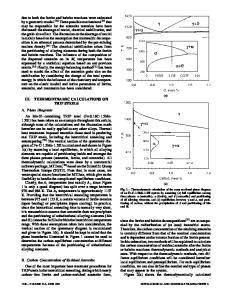Tetragonality of bcc Phases in a Transformation-Induced Plasticity Steel
- PDF / 1,434,889 Bytes
- 5 Pages / 593.972 x 792 pts Page_size
- 77 Downloads / 346 Views
steels, during cooling from the austenitization temperature, polygonal ferrite, bainite, and martensite can form sequentially. It is well known that polygonal ferrite forms via a diffusional mechanism at a slow cooling rate from the austenitization temperature, according to the equilibrium Fe-C phase diagram, leading to a body-centered cubic (bcc) structure.[1] Under rapid cooling conditions from the austenitization temperature, martensite is formed. This occurs via a displacive mechanism, in which all atoms move some fractions of an interatomic distance, resulting in a body-centered tetragonal structure in medium- to high-carbon steels.[2] At intermediate cooling rates, bainite forms in a temperature range between those at which polygonal ferrite and martensite form. This has
ZHIPING XIONG and AHMED A. SALEH are with the School of Mechanical, Materials, Mechatronic and Biomedical Engineering, University of Wollongong, Wollongong, NSW, 2522, Australia. DAVID R.G. MITCHELL is with the Electron Microscopy Centre, University of Wollongong, Wollongong, NSW, 2500, Australia. ELENA V. PERELOMA is with the School of Mechanical, Materials, Mechatronic and Biomedical Engineering, University of Wollongong and also with the Electron Microscopy Centre, University of Wollongong. Contact e-mail: [email protected] Manuscript submitted May 6, 2018.
METALLURGICAL AND MATERIALS TRANSACTIONS A
led to a decades-old debate as to whether or not the bainite formation mechanism is diffusion-controlled[3] or displacive-controlled.[4] Recently, the carbon content in defect-free lath bainitic ferrite (BF) has been measured using atom probe tomography (APT) and has been found to be higher than para-equilibrium.[5–9] This demonstrates the assumption that this phase contains excess carbon due to trapping of carbon at defects is not correct.[5] Tetragonality (distortion) of the bcc lattice occurs commonly in high-carbon martensite where an ordered structure of solute carbon atoms results from the shear mechanism of phase transformation manifesting in carbon super-saturation compared to the equilibrium state of ferrite.[10–14] It was also suggested to be the reason for the observed carbon super-saturation in BF laths.[15] In-situ synchrotron, neutron, and X-ray diffraction (XRD) obtained from a range of different steels after suitable aging (as listed in Table I) showed that the resulting BF laths had tetragonality. In addition, a decrease in tetragonality of BF laths occurred with increasing holding time of bainitic steels as a result of the carbon diffusing from the BF lath to the neighboring austenite.[6,17] The tetragonality of BF laths in bainitic steels has received significant attention.[6,8,16,17] However, limited data are available for bcc phases in multi-phase steels. In addition, it is very important that advanced technologies should be employed in tetragonality characterization as new scientific information could be found because of improved accuracy. The present paper studies the tetragonality in bcc phases (polygonal ferrite, BF laths, a
Data Loading...











